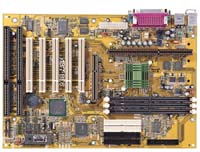ABIT has long been known as the king of overclocking. After all, their BH6 was by far the most recommended motherboard for overclocking the Celeron 300A thanks to its ability to adjust the CPU's core voltage. ABIT followed up with the BX6 Revision 2.0, which offered more bus speeds and an additional DIMM slot. With other manufacturers catching up in the overclocking race by providing the above features, ABIT has gone with something different on their most recent i440BX boards. On the BP6, it was the first dual processor Socket-370 board and included a UDMA/66 controller on board. So what is this new BE6?
New Anand Tech Report Card Rating 86/B
| CPU Interface | Slot-1 |
| Chipset | Intel 440BX |
| L2 Cache | N/A (on-chip) |
| Form Factor | ATX |
| Bus Speeds | 66 / 75 / 83 100 / 105 / 110 / 112 / 115 120 / 124 / 133 / 140 / 150 |
| Clock Multipliers | 2.0x - 8.0x |
| Voltages Supported | 1.30v - 2.3v (0.05v increments) |
| Memory Slots | 3 168pin DIMM Slots |
| Expansion Slots | 0 AMR Slots 1 AGP Slot 5 PCI Slots (5 Full Length) 2 ISA Slots (1 Shared / 0 Full Length) |
| BIOS | Award 4.51PG w/ ABIT SoftMenu II |
The Good
Take the BX6 Revision 2.0, BH6, and BP6, throw into a big pot and mix thoroughly and you get the BE6 we have here. When you first pull the BE6 out of the box, you get a strange sense of deja vu if you've ever worked with ABIT's i440BX boards. The 5/2/1 expansion slot configuration (PCI/ISA/AGP) comes straight from the BX6R2. The 3 DIMM slots made it over from the BH6 - space and cost concerns most likely kept the fourth DIMM slot from making it to the production BE6. The HighPoint HPT366 controller is the same one used on ABIT's own BP6 and HotRod 66 controller.
The ATX specification is also closely followed with all major components strategically placed to minimize cable clutter and provide the most room to work around the board. All HDD/FDD connectors are located where they should be, right at the front of the board, so that no cables are forced to run over the CPU and/or memory. The ATX power connector is unfortunately located at the back of the board, next to the Slot-1 connector. That means that the power cable will have to run over the CPU and memory, reducing airflow to the CPU and cluttering up the inside of the system. The front panel connectors will prevent the use of a full length card in one ISA slot, while the other is blocked by a fan connector. Fortunately, all 5 PCI slots can accept full length cards. The UDMA/66 connectors are color coded white to help differentiate things at a glance, while the entire back panel I/O looks like a rainbow for PC99 compliance.
Although Soyo, AOpen, IWill and others are now including support for core voltage adjustment in the BIOS, ABIT was the founder of this technique for Slot-1 motherboards. All of their i440BX boards have included this feature and the BE6 is no exception. The board supports core voltages from 1.40v up to 3.2v in 0.05v increments, a feature which has been known to make a huge difference in the stability of an overclocked system. Just like the BX6R2, ten 1000uF capacitors aid in providing stable power to the CPU. Just like other ABIT boards, the BE6 has merely average stability in non-overclocked situations. Thanks to SoftMenu II and its core voltage adjustments, overclocked stability is quite high - especially in a borderline overclocked situation where an extra 0.1V can do amazing things.
The BE6's SoftMenu II takes advantage of the new clock generator by providing support, albeit unofficially, for a total of 13 FSB settings. Although we praised ABIT for their excellent FSB options on the BP6, the BE6 offers much more conventional support. In addition to the standard 66/75/83/100/124/133MHz FSB settings, the BE6 supports 105 / 110 / 112 / 115 / 120 / 140 / 150, with 124 and above supporting a 1/4 PCI ratio to keep the PCI frequency as close to the specified 33MHz setting as possible, for those with extremely frequency sensitive PCI peripherals. These bus speeds are not quite as beneficial as those offered on the BP6 for Celeron users, but are better for Pentium III owners.
The AGP clock is also derived from the FSB frequency, and the BE6's SoftMenu II does offer the ability to select from a 1:1 or a 2:3 FSB ratio for the derivation of the AGP frequency, keeping the clock as close to the rated 66MHz frequency as possible. Complaining about ABIT not including any other AGP ratios is quite futile as the motherboard has nothing to do with the AGP frequency, which is actually stored in the chipset itself and only selected through the motherboard, leaving the 1:1 and 2:3 ratios as the only two options with the i440BX chipset. Recently, we finally had a chance to take a look at the VIA Apollo Pro Plus 133 that does offer official support for the 133MHz FSB and thus a 1:2 AGP ratio. We'll have to wait until Camino (i820) for an Intel chipset to support such a feature.











0 Comments
View All Comments